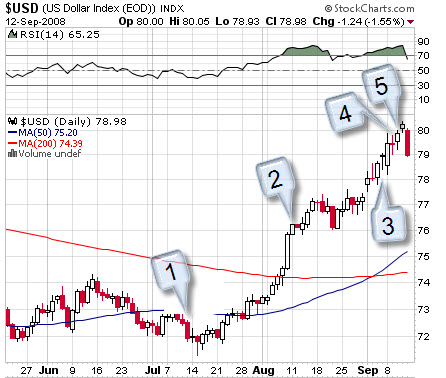A question of vital importance is whether the recent dollar rally is real or fake. If fake, it is an engineered outcome of central bank policy (US, EU and JP combined) and it will fail, possibly spectacularly.
If real, it could portend a major trend shift with powerful implications for commodities, interest rates, and the stock market.
At the highest level, like any commodity, money will rise in the international markets when there are more buyers than sellers. It will fall when there are more sellers than buyers.
Here are the legitimate (non-intervention) reasons that there would be more buyers:
- US dollars are needed to pay off or settle debts denominated in US dollars. Suppose that foreign banks had large positions in US interest rate swaps (a derivative), which they were only holding in their trading accounts as a notional value, and suddenly had to settle up in dollars. This would create demand for dollars.
- The Yen “carry trade” was still growing. In this scheme a hedge fund (for example) would borrow Yen at a low interest rate, sell those Yen into the global market, and buy dollars, which are then invested in higher-yielding US treasuries. This creates demand for dollars.
Here are the reasons that there would be more sellers:
-
Trade deficit remains high. The trade deficit means that US consumers and businesses are importing more than they’re exporting. When this happens, dollars flow out of our borders to foreign manufacturers, which have to convert the dollars into their local currency. Dollars get sold to accomplish this.
- These dollars are then absorbed by the local central bank, which then decides whether to hold them or sell them. One way of holding them is to hand them back to the US, where they are held in a special “custody account” at the Fed. Over the past year, this account is up a whopping $414 billion. Over the past week, it has actually fallen, indicating that perhaps the dollar’s mysterious climb is about over. (http://www.federalreserve.gov/releases/h41/Current/)
- The US budget deficit remains high. With a big, sustained fiscal deficit, the US government is, in effect, creating more spending than economic growth. A large fiscal deficit implies that inflation is coming, and, all things being equal, it should create less of an appetite for US dollars. Since the US dollar is the reserve currency, this dynamic is muted (at present), but it is certainly a factor for all other countries and should (will) play a role here as well.
- The US interest rate remains below that of other countries. This is most assuredly the case, where the US is a full 2% or more below the rate offered by other industrialized (and safe) countries.

Data Point #1
U.S. federal deficit balloons to $268.7B
WASHINGTON – The U.S. Treasury Department says the country’s federal deficit swelled to $268.7 billion in the first nine months of this budget year [October to June] as record spending during the period outpaced revenues.
Data Point #2
Federal Budget Deficit Hits $102B In July
WASHINGTON (AP) ― The federal budget deficit soared in July, pushed higher by economic stimulus payments and $15 billion in outlays to protect depositors at failed banks.
The Treasury Department reported that the deficit for July totaled $102.8 billion, nearly triple the $36.4 billion deficit recorded in July 2007.
Data Point #3
Dollar rises as yen slides on Government take-over of Freddie, Fannie
LONDON (Reuters) – The dollar jumped against a broadly weaker yen and rebounded against a host of currencies on Monday after the U.S. government took control of Fannie and Freddie Mac
Data Point #4
Federal Shortfall To Double This Year
A weak economy and a sharp increase in government spending will drive the federal budget deficit to a near-record $407 billion when the budget year ends later this month, and the next president is likely to face a shortfall in January of well over $500 billion, congressional budget analysts said yesterday
Data Point #5
US July trade deficit widens to $62.2 bln vs $58.0 bln expected
WASHINGTON (Thomson Financial) – Record high US petroleum imports and record high prices for an imported barrel of oil led the US trade deficit to widen more than expected in July to its highest level since March 2007, the Commerce Department reported Thursday.
Commerce reported a $62.2 bln deficit in July, up 5.7% from the revised $58.8 bln trade gap in June.
Back to my original question. Overall, I am going to have to answer "fake" for this dollar rally, at least on the basis of observable fundamentals. Of course, I have no hard data around the potential need for dollars as derivative bets get unwound, so this could be in error.


